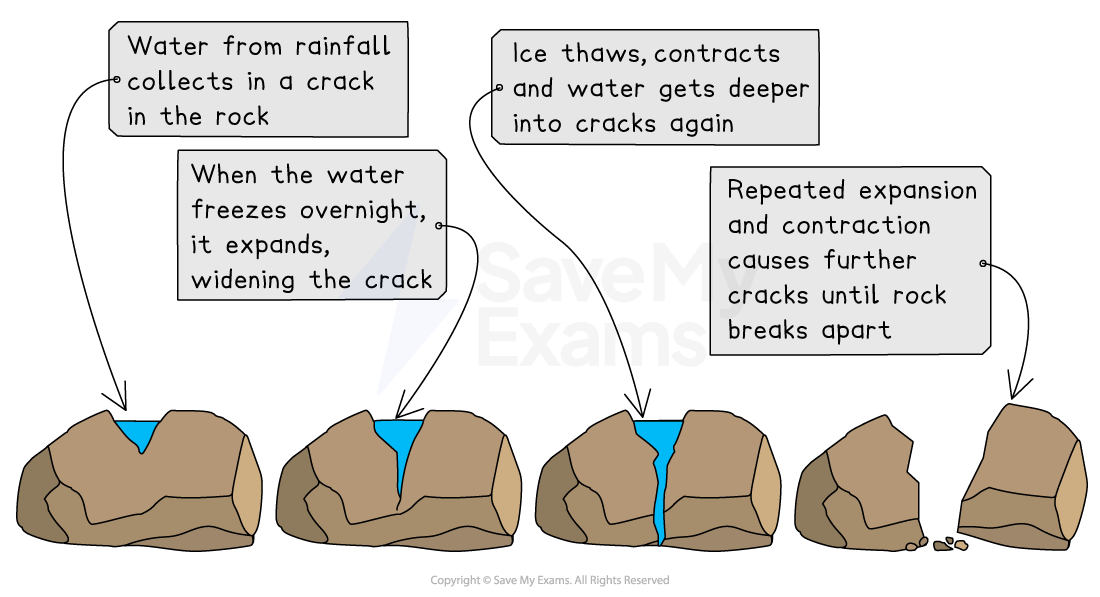Coastal land processes in the UK (WJEC Eduqas GCSE Geography B): Revision Note
Exam code: C112
Specification links
The notes on this page cover part 2.1.1 of the WJEC Eduqas B specification - How do people and processes contribute to the development of distinctive coastal landscapes in the UK?
Geomorphological processes must include weathering and mass movement.
Coastal geomorphic process
The coast is the area where land and sea meet
A geomorphic process is any natural action that alters the shape of the Earth's surface and includes:
weathering
erosion
mass movement
transportation
deposition
Coastal geomorphological processes are divided into two parts:
Terrestrial processes: those that occur onshore and are land-based
Also known as subaerial weathering, it describes coastal processes that are not linked to the action of the sea
Marine processes: those that occur offshore and are water-based
Weathering and the coast
What is weathering?
Weathering is the breakdown of rock in situ
It does not involve the movement of material, making it different from erosion
Weathering weakens cliffs and makes them more vulnerable to erosion
Types of weathering
There are three types of subaerial weathering: mechanical, chemical, and biological.
Mechanical weathering physically breaks up rock
Freeze-thaw or frost shattering is where:
Water enters cracks and joints in the rock
As the water freezes, it expands, causing the cracks to open wider
As the water thaws, the crack shrinks, easing the pressure on it
Repeated freezing and thawing over time widens the crack, causing pieces of rock to split off the cliff face
Big boulders break into smaller rocks and gravel

Chemical weathering occurs when rocks are broken down by a chemical process:
Rainwater is slightly acidic due to absorbing carbon dioxide from the atmosphere
This reacts with minerals in the rock, creating new material
Rock type affects the rate of weathering, e.g. limestone chemically weathers faster than granite
The warmer the temperature, the faster the chemical reaction
Biological weathering is when living organisms wear rocks away:
Trees and other plants can grow within the cracks in a rock formation
As the roots grow bigger, they push open cracks in the rocks, making them wider and deeper
Over time, the growing tree eventually prises the rock apart
Burrowing animals, such as rabbits, disturb the ground above the burrow, which puts pressure on any cracks, eventually leading to pieces falling off the rock
Mass movement and the coast
Mass movement is the downhill movement of material under the influence of gravity
Heavy rain can also make cliffs less stable and make mass movement more likely through throughflow and runoff
It includes landslides, slumping and rockfalls
The following factors determine the type of movement:
Angle of slope (the steeper the slope, the faster the movement)
Nature of regolith
Amount and type of vegetation
Water
Type and structure of rock
Human activity
Climate
Soil Creep:
It often occurs in humid areas, moving less than 1 cm each year.
Soil expands when it freezes, gets wet, or heats up in the sun
The soil expands and lifts at right angles to the slope
When the soil shrinks, it drops straight down
Soil creep happens slowly as the soil shifts just a millimetre to a few centimetres at a time
Flow:
Happens on slopes from 5° to 15° at speeds of 1 to 15 km per year
It usually occurs after the soil gets saturated with water flowing across the surface
Flattened vegetation gets carried away with the soil
Slide:
A mass of material moves together until it reaches the bottom of a slope
Fall:
Slopes rise sharply, and movement happens quickly
Several reasons caused this.
Extreme weathering: Freeze-thaw action loosens rocks, making them unstable and causing collapse
Excess rain will soften the surface and cause the slope to collapse
Earthquakes dislodge unstable rocks
Hot weather dries out soil, causing it to shrink and rocks to fall
Slump:
Typically located on weaker rock types like clay that get saturated and heavy
This occurs often at the coast and is called rotational slip
A large area of land moves down the slope in one piece
It slumps and leaves a curved, indented surface

Worked Example
Outline two ways that subaerial processes can affect the shape of a cliff.
[4 marks]
Answer
Freeze-thaw weathering occurs as temperatures go above and below 0° C. [1 mark] Water trapped in the rock expands and exerts pressure as it freezes. As temperatures rise, the water melts, and pressure is released. Repeated cycles eventually break the rock. Winter experiences more freeze-thaw cycles than summer, which causes more erosion of the cliff. [1 mark]
The temperature and type of rock determine how quickly chemical weathering dissolves it. Both seawater and rainwater are slightly acidic. [1 mark] Limestone reacts with the acid in water faster than granite because it is less resistant. Therefore, softer rock cliffs weather faster than harder rock ones. The warmer the temperature, the faster the reaction; therefore, cliffs will chemically erode faster in summer than in winter. [1 mark]
Marking guidance
2 marks available for each identified subaerial process
1 mark for the processes
1 mark for the explanation
Alternative content
There are three sub-aerial processes that can be used to answer this question
Freeze-thaw, chemical and biological
An explanation of how each process works, and then linked to show how it would change the shape of a cliff

Unlock more, it's free!
Did this page help you?